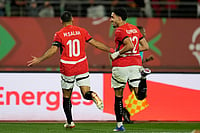Down a lane off the South Bombay sea face, along dark narrow passages and up an ancient stairway is the office of the Board of Control for Cricket in India. It's a somewhat impoverished office, dressed like a government outfit with steel cupboards and wooden peons.
In one corner is the cabin of Ratnakar Shetty, who went to Pakistan as the manager of the Indian cricket team. Inside, on a spare table, rest two identical golden trophies, one for India's 3-2 win in the one-day series and the other for its 2-1 Test series victory.
Touch, feel and lift them respectfully. What they represent was among India's greatest sporting pursuits, though for the moment they stand here like giant paperweights. When Shetty is ready to leave, he throws a bored look around his cabin, switches off the lights and shuts the door. The Samsung cups will remain there, through the long night's emptiness. One part of how they got to Shetty's room must be told.
During the 2003 World Cup, team coach John Wright was asked by someone, "The Indian team is full of superstars. They have played more matches than you ever have. Do you think they listen to you?"
Wright paused a moment, chuckled with partial embarrassment and said, "I hope they do." Well, it's confirmed now, they really do. In a country where individuals are above the system, where some filmstars are known to say "cut", cricket was unsurprisingly ruled by its famous men. Coaches were merely employees, and certainly not the bosses. But today, when John Wright decides the team will go for a swim or descend to the gym, everyone, including the Mercedes and the one Rolls Royce of Indian cricket, will be there on time.
Wright even rebukes the side with gentle firmness as he did on the fourth day of the final Test in Rawalpindi, after several catches were dropped. He was disappointed with his side for giving so many breathers to the dying enemy. Wright wanted India to win by as big a margin as possible because, according to one player, he wanted Pakistan to be intimidated by India in the future.
His preparation before every match, Shetty remembers, "was amazing". Team meetings during the Pakistan tour were usually held in conference halls of hotels, the coach fully armed with video footage for the hour-long war plan. Only in one small area has coach Wright had to concede defeat. He has often told his players that they could borrow cricket books from him. "For leisure reading," as he put it at dinner before the Multan Test. "I must say nobody has actually ever borrowed a book." Most Indian cricketers aren't the reading types. "That's not bad in a way," reasons Wright, "perhaps sometimes cricket is over-analysed."
His obsession with fitness has brought about the most significant change in Indian cricket. Today, Indian cricketers really do look like sportsmen—their paunches are steadily vanishing. "Earlier, senior players would go for a drink after a day's play," Anil Kumble said before the Test series began, "now we go to the gym."
Another important change is the end of bitter wars within the camp, a distinct break from the tradition of team sports in the subcontinent. This was a crucial difference between the two sides. It's unthinkable for an Indian fast bowler today to announce that he is not happy with his captain's field placements—which was what Shoaib Akhtar did. With Virender Sehwag and Yuvraj Singh as the dressing room jesters, a job that Vinod Kambli used to perform efficiently earlier, it's a team full of famous men who have stayed away from the complications of fame.
Sachin Tendulkar's statement in Multan that he was "disappointed" with Rahul Dravid's decision to declare the innings when he was close to a double century was a rare moment of public acrimony. Though this was to embarrass Dravid through the tour, Tendulkar's statement was not destructive, as it might have once been. Such is the "mutual respect in the side", according to a team member. Dravid met Tendulkar the day of his declaration and the good friends brushed the whole issue aside. But more was to come. Later during the Test when Dravid was surfing the net he found an article that quoted Ganguly as saying that he would have reacted just the way Tendulkar did. That made Dravid go to the team manager, Shetty, and ask for an explanation. Shetty asked Ganguly to sort it out. Ganguly, in turn, sought out the journalist who had filed the story. When the journalist spoke to Ganguly from the house phone in the team hotel's reception, the Indian captain brought Dravid on a parallel line so that all three could settle the matter. After this, Ganguly was seen stepping out into the hotel lobby with a wide grin. He told a friend, "The guy (the journalist) says he could not find me, so he quoted me!"
Still, Ganguly's relationship with his senior players has not always been pleasant in recent years. In a team that is always in some kind of a friendly huddle even outside the cricket field, Ganguly tends to appear a little aloof. Nevertheless, he is still regarded as the architect of this new Indian side, young, vigorous and athletic. And that has created a problem many teams will love to face. An embarrassment of riches. Especially in the Test squad.
Once, Shiv Sundar Das was the only Indian hope for opening the batting in a Test. Today with Virender Sehwag sealing one end, Yuvraj Singh, Parthiv Patel and Akash Chopra are fighting for the other spot. Chopra, whose longevity in Australia greatly frustrated that country's pace ammunition and crucially affected the results, had to be dropped in the Rawalpindi Test to let Ganguly in after the captain recovered from injury.
So what is the Indian team today? Rotation is an unlikely solution in Tests. With Patel receiving the full backing of John Wright as keeper-batsman, his performance in two innings in Pakistan perceived as both brave and classy, and Dravid stating clearly that his keeping in Tests is "impossible", the Gujarati cannot be dislodged for the moment. Between Yuvraj Singh, Chopra and Ganguly, someone will have to go.
In bowling, the situation will be similar when Zaheer Khan returns from injury. One out of Pathan, Balaji or Nehra may be dropped, despite impressive performances in Pakistan. Or Kumble could be sacrificed in an unprecedented decision to play a Test without a spinner. If there is a spinner, it could instead be Harbhajan. Now, it seems we have an Australian state of things.
Stacked In Spades
John Wright has moulded a team of famous men uncomplicated by the ways of fame. Now it's a problem of plenty.

Stacked In Spades
Stacked In Spades
Published At:
MOST POPULAR
WATCH
MORE FROM THE AUTHOR
×

















